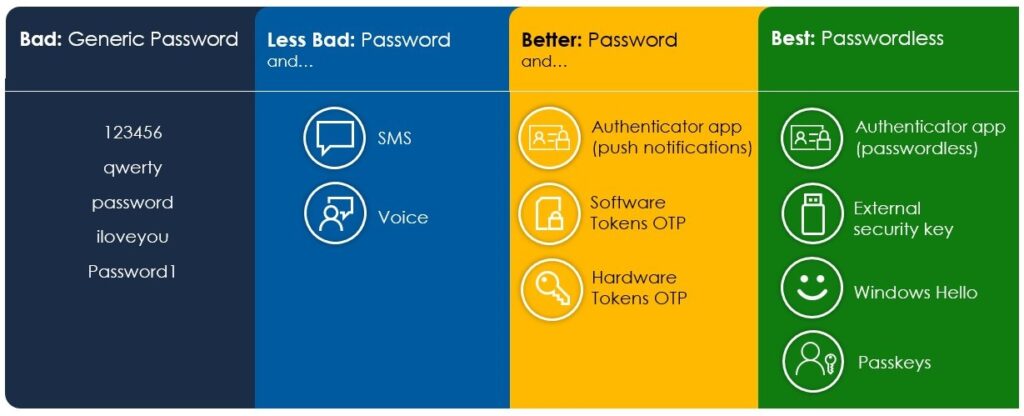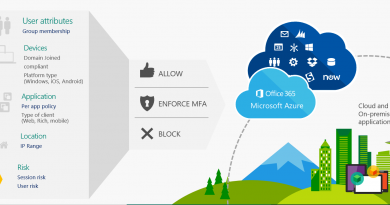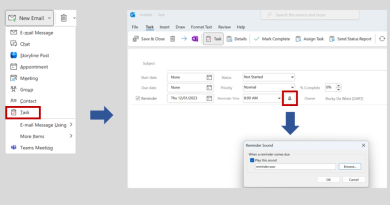How Microsoft can help you go passwordless this World Password Day
It’s that time of year again. World Password Day is May 4, 2023.1 There’s a reason it’s still going strong 10 years after being created by cybersecurity professionals. A recent study that analyzed more than 15 billion passwords found that the top 10 most popular passwords still include easy-to-crack combinations like “123456” and “qwerty.”2 With that level of security, many organizations are essentially leaving the front door open. Sharing your password for a streaming service may seem harmless (their accountants might disagree), but this behavior sometimes bleeds into the workplace, where weak or shared employee passwords often become one of the largest security threat vectors that companies face.
In 2022, Microsoft tracked 1,287 password attacks every second (more than 111 million per day).3 Phishing is an increasingly favored attack method, up 61 percent from 2021 to 2022.4 And our data for 2023 shows that this trend is continuing. Passwords should play no part in a future-looking credential strategy. That’s why you don’t need a password for Microsoft Accounts—hundreds of thousands of people have deleted their passwords completely.5
For stronger, streamlined security, Microsoft passwordless authentication can help your organization eliminate password vulnerabilities while providing simplified access across your entire enterprise. In honor of World Password Day, this blog will help you make the case to your organization that when it’s time to “verify explicitly” as part of a Zero Trust strategy, modern strong authentication using phishing-resistant passwordless credentials provide the best security and an excellent return on investment (ROI).
Go passwordless for simplicity, security, and savings
If you’ve read my blog on why no passwords are good passwords, you know my feelings on this subject. To quote myself: “Your password isn’t terrible. It’s definitely terrible, given the likelihood that it gets guessed, intercepted, phished, or reused.” As Microsoft Chief Information Security Officer Bret Arsenault likes to say, “Hackers don’t break in—they log in.”
Passwords alone are simply not sufficient protection. Old-fashioned multifactor authentication bolts a second factor onto a password to add a layer of protection, but the most popular of these—telephony—is also the most problematic (see my blog about hanging up on phone transports to understand why telephony is a poor option for multifactor authentication). Even with strong methods, like using Microsoft Authenticator to augment a password, you still have the vulnerability of the password itself. The best password is no password—and you can get there today with Windows Hello, security keys, or, my favorite, Microsoft Authenticator.

Figure 1. Identity protection methods are not made equal; certain protections are far more secure than others.
In 2022, Microsoft committed to the next step of making passwords a thing of the past by joining with the FIDO Alliance and other major platforms in supporting passkeys as a common passwordless sign-in method. Passkeys aim to not only replace passwords with something more cryptographically sound, but that’s also as easy and intuitive to use as a password. Passwordless technology, such as Windows Hello, that’s based on the Fast Identity Online (FIDO) standards, strengthens security by doing the verification on the device, rather than passing user credentials through an (often vulnerable) online connection. It also provides a simplified user experience, which can help boost productivity as well.
That was the goal when longtime Microsoft collaborator Accenture decided to simplify their user experience by removing the requirement for password authentication. With 738,000 employees spread across 49 countries, the company decided it was in its best interest to make their identity and access management (IAM) automated and easy. Accenture chose the Microsoft Authenticator app, Windows Hello for Business, and FIDO2 security keys as its passwordless authentication solutions. As described in their case study, the results are already being felt: “The adoption of passwordless has led to faster login times, more reliable experience, fewer failed authentications, and improved overall security posture.”6
Whether you’re part of a global organization like Accenture or a small startup, the authentication methods policy in Microsoft Azure Active Directory (Azure AD)—now part of Microsoft Entra—allows your IAM team to easily manage passwordless authentication for all users from a single pane of glass. Even better, a recent Forrester Consulting study found that a composite organization based on interviewed customers securing its business apps with Azure AD benefited from a three-year 240 percent ROI (a net present value of USD8.5 million over three years) while reducing the number of password reset requests to its help desk by a significant 75 percent annually.7
Multifactor authentication can’t do it all
A 2021 report by the Ponemon Institute found that phishing attacks were costing large United States-based companies an average of USD14.8 million annually.8 That’s way up from 2015’s figure of USD3.8 million. Microsoft alone blocked 70 billion email and identity attacks in 2022. But on the positive side, multifactor authentication has been shown to reduce the risk of compromise by 99.9 percent for identity attacks.9 That’s a pretty stellar statistic, but it’s not bulletproof; especially when considering that SMS is 40 percent less effective than stronger authentication methods.10 Attackers are always learning and improvising, as shown in the rise of multifactor authentication fatigue attacks. In this type of cyberattack:
- The threat actor uses compromised credentials (often obtained through a phishing attack) to initiate an access attempt to a user’s account.
- The attempt triggers a multifactor authentication push notification to the user’s device, such as “Did you just try to sign in? Yes or no.”
- If the targeted person doesn’t accept, the attacker keeps at it—flooding the target with repeated prompts.
- The victim becomes so overwhelmed or distracted, they finally click “yes.” Sometimes the attacker will also use social engineering, contacting the target through email, messaging, or phone pretending to be a member of the IT team.
One widely publicized multifactor authentication fatigue attack happened in September 2022, when an 18-year-old hacker used the compromised credentials of a contractor to gain access to a major rideshare company’s internal networks. Once inside, he was able to access tokens for the company’s cloud infrastructure and critical IAM service. Our research was ahead of this type of attack back in 2021 when we built multifactor authentication defenses into the Authenticator app, including number matching and additional context. To learn more, be sure to read my blog post: Defend your users from multifactor authentication fatigue attacks.
All identity protection rests on Zero Trust
Zero Trust is just another way of describing proactive security. Meaning, it’s the measures you should take before bad things happen, and it’s based on one simple principle: “Never trust; always verify.” In today’s decentralized, bring-your-own-device (BYOD), hybrid and remote workplace, Zero Trust provides a strong foundation for security based on three pillars:
- Verify explicitly: Authenticate every user based on all available data points—identity, location, device health, service or workload, data classification, and anomalies.
- Use least-privilege access: This means limiting access according to the user’s specific role and task. You should also apply risk-based policies and adaptive protection to help secure your data without hindering productivity.
- Assume breach: This allows your security team to minimize the blast radius and prevent lateral movement if a breach occurs. Maintaining end-to-end encryption and using analytics will also strengthen threat detection and improve your defenses.
And when it comes to “verify explicitly” as part of Zero Trust, no investment in the field of credentials is better than a passwordless journey; it literally moves the goalposts on the attackers.
May the Fourth be with you all!
Security year round
At Microsoft Security, we believe security is about people. Empowering users with strong, streamlined access from anywhere, anytime, on any device is part of that mission. Learn more about Microsoft passwordless authentication and how it can help your organization eliminate vulnerabilities while providing fast, safe access across your entire enterprise.
To learn more about Microsoft Security solutions, visit our website. Bookmark the Security blog to keep up with our expert coverage on security matters. Also, follow us on LinkedIn (Microsoft Security) and Twitter (@MSFTSecurity) for the latest news and updates on cybersecurity.
1World Password Day, National Day Calendar.
2Most common passwords: latest 2023 statistics, Paulius Masiliauskas. April 20, 2023.
3Microsoft Entra: 5 identity priorities for 2023, Joy Chik. January 9, 2023.
4Over 255m phishing attacks in 2022 so far, Security Magazine. October 26, 2022.
5The passwordless future is here for your Microsoft account, Vasu Jakkal. September 15, 2021.
6A passwordless enterprise journey, Accenture.
7The Total Economic Impact™ of Microsoft Entra, a commissioned study conducted by Forrester Consulting. March 2023.
8New Ponemon Institute Study Reveals Average Phishing Costs Soar to $14.8M Annually, Nearly Quadrupling Since 2015, GlobeNewswire. August 17, 2021.
917 Essential multi-factor authentication (mfa) statistics [2023], Jack Flynn. February 6, 2023.
10How effective is multifactor authentication at deterring cyberattacks? Lucas Meyer, et al. May 1, 2023.
READ MORE HERE



